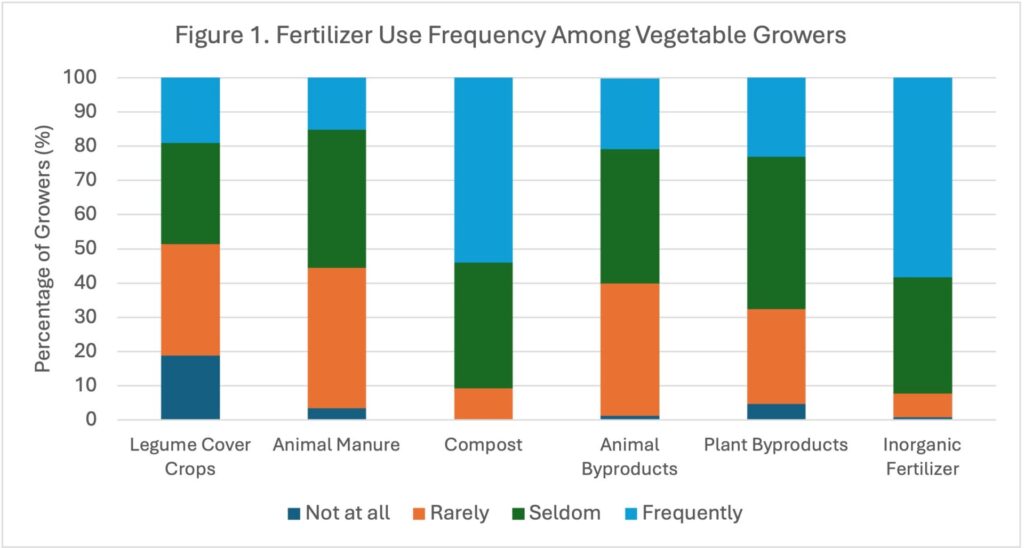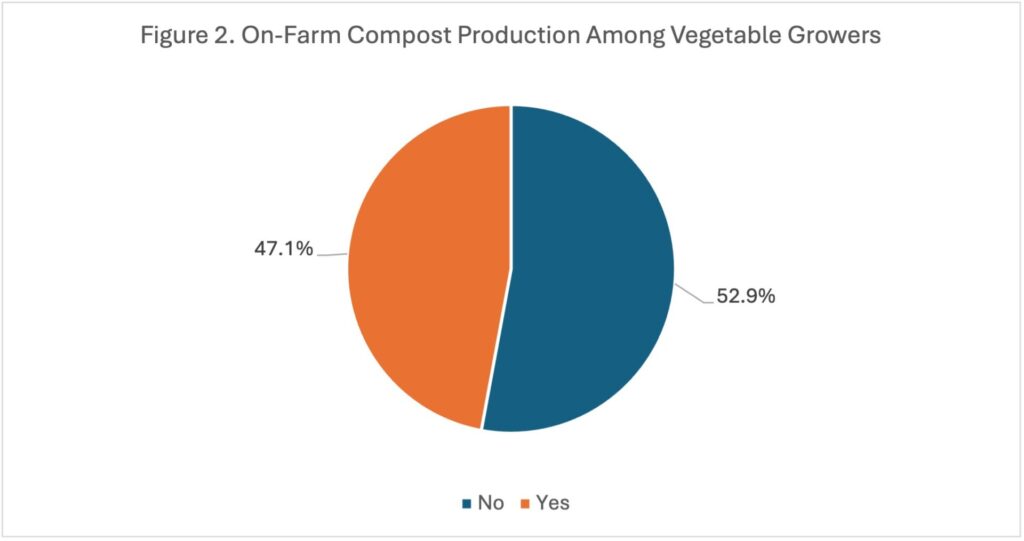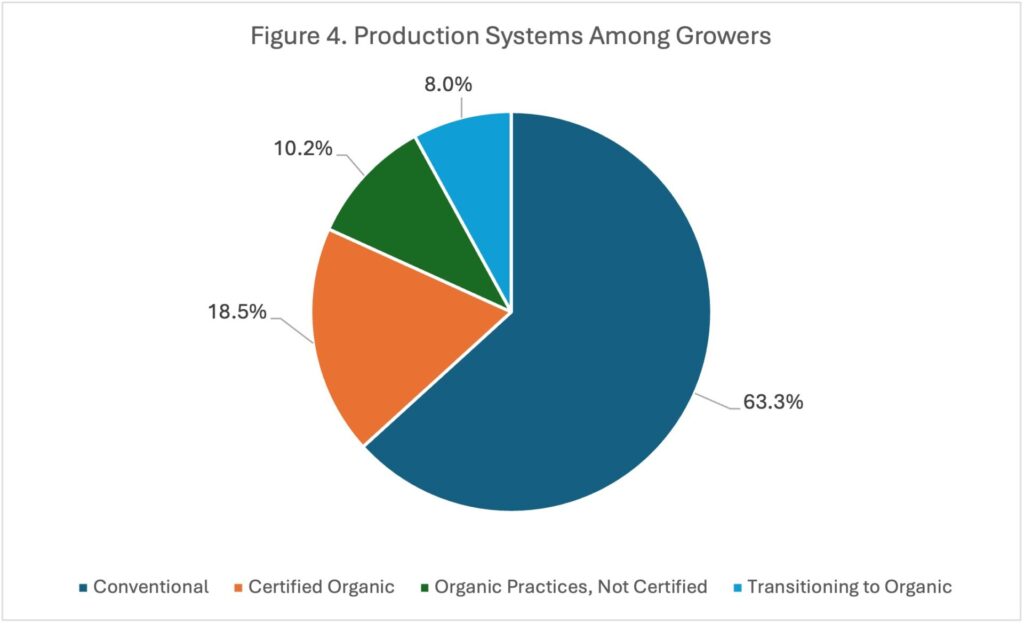Small and medium-sized vegetable farms face unique challenges balancing profitability with sustainable production practices and food safety requirements. To better understand how these farmers navigate complex decision-making processes, the Soil to Market Team—comprising Maria Marshall, Renee Wiatt, Petrus Langenhoven, Betty Feng, and Nathan Shoaf—conducted a comprehensive survey of 500 small and medium-sized farmers across the United States during 2024-2025. This research, funded by the U.S. Department of Agriculture’s National Institute of Food and Agriculture, focuses on holistic farmer decision-making processes.
This article series will present key findings from the survey, offering insights that can help both growers and Extension educators better understand the interconnected nature of farm planning. These findings aim to support more profitable and sustainable vegetable farming operations by examining the relationship between strategic planning and farm performance.
From Soil to Market: How Vegetable Growers Are Integrating Sustainable Practices
Recent survey data from nearly 500 vegetable growers reveals a compelling picture of how growers are making integrated decisions that span from soil health to market demands. The findings highlight a strategic shift toward practices that balance productivity, sustainability, and economic viability in the soil-to-market continuum.
Fertilizer Strategies: Balancing Traditional and Organic Approaches
The survey data shows that vegetable growers employ a diverse fertilizer strategy influenced by careful decision-making across the production cycle (Figure 1). Inorganic fertilizers remain the most frequently used input, with 58% of growers using them frequently. This high adoption rate suggests that conventional fertilizers continue to play a crucial role in meeting immediate crop nutrient needs and market timing requirements.
However, the widespread adoption of compost tells a different story about long-term soil management. Over 90% of growers use compost to some degree, with 54% using it frequently. This represents a significant commitment to soil health that extends beyond single-season production goals. The fact that 47% of growers make their own compost indicates a deep integration of soil building into their overall operation planning (Figure 2).
Animal manure and byproducts show moderate adoption patterns, with most growers using them rarely or seldom. This measured approach likely reflects logistical considerations, regulatory requirements, and the need to coordinate these inputs with market timing and food safety protocols.
Conservation Practices: Building Soil Capital for Market Success
The adoption of conservation practices reveals how growers are thinking systematically about soil-to-market connections (Figure 3). Crop rotation shows remarkable adoption, with 89% of growers using it to a moderate degree or more. This practice exemplifies integrated decision-making, as rotation decisions must account for soil health, pest management, market demand cycles, and labor scheduling.
Conservation tillage practices are used by 76% of growers to some extent, indicating that they recognize that soil structure preservation supports both environmental goals and consistent crop quality. Strip cropping, used by nearly all growers surveyed, demonstrates how growers are managing field-level variability to optimize both soil protection and harvest efficiency.
The data reveals an important distinction in how growers approach cover crops. When asked specifically about legume cover crops as a fertilizer input, as shown in Figure 1, only 19% of growers use them frequently. These are nitrogen-fixing species like sunn hemp, crimson clover, hairy vetch, and winter peas grown primarily for their fertilizer value. However, when asked about cover crops as a conservation practice more broadly (Figure 3), 81% of growers use them to some degree. This significant difference (19% vs 81%) indicates that growers are selecting from a diverse toolkit of cover crop species to meet multiple objectives simultaneously. Rather than focusing solely on nitrogen fixation, growers are choosing cover crops for soil protection, weed suppression, organic matter building, and compatibility with their planting schedules. This broader approach reflects integrated thinking that considers cover crops as multi-functional tools in the soil-to-market system rather than simple fertilizer replacements.
Production Systems: Meeting Market Demands Through Diverse Approaches
The production system data reveals strategic market positioning, with 63% of production remaining conventional while 37% involves some form of organic practices (Figure 4). The 18.5% certified organic segment represents growers who have made comprehensive soil-to-market commitments, often commanding price premiums that justify the intensive management required.
The 10% using organic practices without certification suggests growers who are integrating sustainable soil management for reasons beyond market premiums—possibly focusing on soil health, certification cost savings, or preparing for future market opportunities. The 8% transitioning to organic represents active investment in soil building and market repositioning.
Integrated Decision-Making in Practice
These survey results demonstrate that successful vegetable growers are making decisions that integrate soil health, production efficiency, and market requirements. The high adoption of compost and crop rotation alongside continued reliance on inorganic fertilizers suggests that growers are building soil health capital while maintaining production reliability.
The prevalence of conservation practices across production systems indicates that building soil health has become integral to business planning rather than an add-on consideration. Growers appear to recognize that healthy soils support consistent quality, reduce input costs over time, and provide resilience against weather variability, which are all factors that affect market success.
Implications for Extension and Advisory Services
These findings suggest that vegetable growers are ready for technical information that addresses integrated systems rather than single practices. Extension programming that connects soil health practices to harvest timing, post-harvest quality, and market positioning will likely resonate with producer decision-making processes.
The high rate of on-farm compost production indicates strong interest in closed-loop nutrient management, suggesting opportunities for technical assistance in compost quality, timing, and integration with other fertility inputs.
As the vegetable industry continues evolving toward more integrated production systems, the soil-to-market perspective will become increasingly important for maintaining both environmental sustainability and economic viability in vegetable production.
Reference
Wiatt, R., Marshall, M.I., Feng, Y., Langenhoven, P., and Shoaf, N. (2024-2025). Soil to Market Producer Survey on Integrated Decision-Making Survey [data file and codebook]. IRB-2024-1552. Funded by USDA-NIFA-AFRI: Taking the Next Step as a Small and Medium Sized Farm: Understanding the Integration of Production, Food Safety, and Profitability.
Funding Acknowledgement
This work is supported by the Agriculture Food Research Initiative-Small and Medium Sized Farms Program, project award no. 2021-68006-33893, from the U.S. Department of Agriculture’s National Institute of Food and Agriculture.
Any opinions, findings, conclusions, or recommendations expressed in this publication are those of the author(s) and should not be construed to represent any official USDA or U.S. Government determination or policy.




